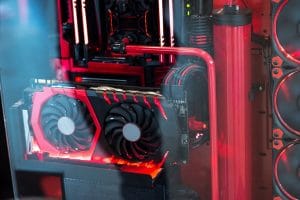 When it comes to advanced technology, the rule is usually that the more powerful an application is, the more complex its design must be. Fitting high-powered technology into smaller, sleeker, and more manageable systems takes innovation, and that often means designing applications that can accomplish more than their predecessors. However, in the realm of thermal management, achieving more has meant simplifying the processes by which systems control electrical waste heat. Rather than utilizing more complex equipment, heat exchangers use methods such as natural/forced convection to achieve the high-performance thermal management that advanced technology requires.
When it comes to advanced technology, the rule is usually that the more powerful an application is, the more complex its design must be. Fitting high-powered technology into smaller, sleeker, and more manageable systems takes innovation, and that often means designing applications that can accomplish more than their predecessors. However, in the realm of thermal management, achieving more has meant simplifying the processes by which systems control electrical waste heat. Rather than utilizing more complex equipment, heat exchangers use methods such as natural/forced convection to achieve the high-performance thermal management that advanced technology requires.
What does natural/forced convection mean?
Convection is the natural movement of a fluid that becomes less dense, and therefore, more easily transferable, as it absorbs heat. Forced convection is the use of minimal equipment, such as external fans, to facilitate faster movement of the less dense fluid. The combination of natural movement caused by gravity and the additional force generated by simple, non-obtrusive fans helps heat exchangers create a loop in which a cooling fluid can absorb waste heat and transfer it continuously. This allows heat exchangers to successfully prevent electrical overheating without the need for more complex cooling methods.
How do heat exchangers take advantage of it?
In modern heat exchangers, an eco-friendly cooling fluid (such as water) is used to absorb large amounts of electrical waste heat before evaporating. The process prevents any notable rise in temperature as the fluid absorbs the heat, and once it evaporates, natural/forced convection methods can quickly transfer it to a cooler area of the heat exchanger. Once the fluid releases the heat safely away from sensitive components, it condenses back into liquid, regaining its density and flowing back toward the heat source to continue to heat transfer cycle.
How can transferring heat benefit companies?
The process of using a fluid’s latent of heat vaporization and natural/forced convection (commonly known as phase-change cooling) isn’t just simpler and more manageable than traditional air chilling methods. It’s also more cost and energy efficient, more adaptable to increasing thermal management demands, and more eco-friendly. As companies rely on them more, the many different savings and benefits associated with streamlined thermal management help them gain significant advantages. For more information about how heat exchangers turn convection into high-performance cooling, call Noren Thermal Solutions in Taylor, TX, at 866-936-6736.







